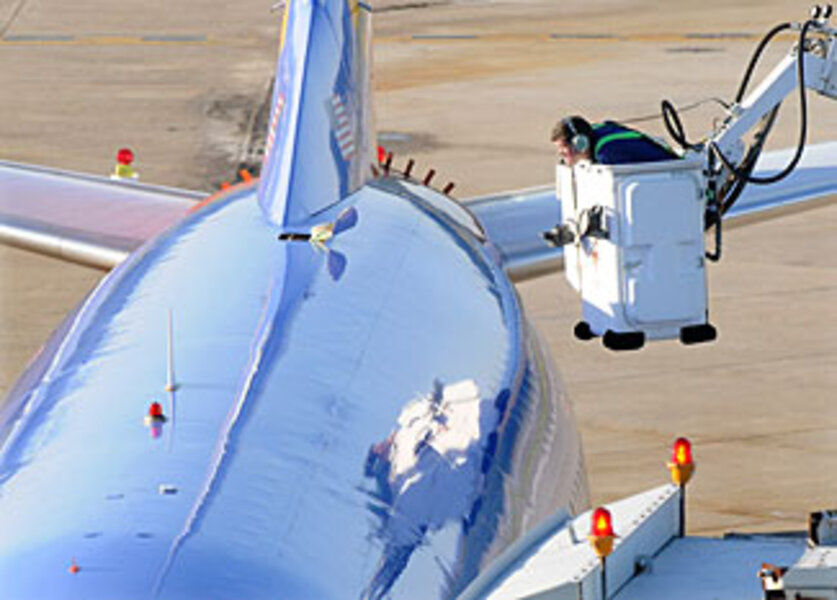What could have torn a hole in jet? Experts stumped.
Loading...
| New York
Southwest Airlines has completed inspecting its entire fleet of Boeing 737-300s – saying it found no problems – after a football-size hole ripped in the fuselage near the back of Flight 2294 and the cabin lost pressure Monday.
The plane, which originated in Nashville and was on its way to Baltimore, made an emergency landing in West Virginia. It landed safely with no injuries to the 131 on board.
The National Transportation Safety Board (NTSB) is currently investigating what happened.
"We've never had anything like this happen at Southwest, which is why we are working so closely with the NTSB and Boeing to figure out exactly why and how this occurred," says Marilee McInnis, a spokeswoman for Southwest Airlines. "We just don't know at this point."
It is very rare for the metal fuselage of a plane to be damaged in flight. The last major accident that involved a fuselage hole was on an Aloha Airlines flight in 1988. A small crack caused by a combination of corrosion and metal fatigue blew open in flight and took a large section of the roof with it. The hole reached from near the cockpit to just before the wing on one side. A flight attendant was sucked out and killed. Sixty people were injured but the plane did manage to land safely.
"That came as a great surprise, but once people figured out what was happening with corrosion, they changed the inspection procedures to be sure that wouldn't happen again," says Clint Oster, an aviation analyst at Indiana University at Bloomington. "We really haven't had any sort of metal fatigue or metal failure kinds of accidents since then."
Southwest has cautioned that it would be "irresponsible" to speculate on what caused the hole in the fuselage at this point. But some aviation analysts note that it's human nature to want to understand what happened.
"Inquiring minds want to know, people will ask and hypothesis will still be offered," says Michael Boyd, president of the Boyd Group, aviation consultants in Evergreen, Colo. "It's unreasonable to expect humans to not want to speculate on something like this."
Several theories are circulating among analysts at the moment. One is fairly simple: An inspection panel on the fuselage may not have been replaced properly and ripped open under the pressure of flight.
The other possibility is the combination of something striking the plane – perhaps a meteor – and metal fatigue. A plane's metal fuselage is pressurized and depressurized many times day. Each time it takes off and lands, it expands and contracts, which potentially can weaken the metal.
"If you hit a piece of metal the right way, it may not shatter right then, but it can be damaged on the molecular level," says Denny Kelly, an aviation analyst and president of Kelly-James Associates, aviation consultants in Coppell, Texas. "Then you start making it expand and contract, and pretty soon it's going to crack and give way."
Others agree that it's certainly possible that something hit the plane. "As to what it might have been, who knows?" says Professor Oster. "There are a lot of possibilities, all of them exceedingly unlikely, but exceedingly unlikely things do happen."
If metal fatigue is believed to be a factor, though, analysts like Mr. Boyd caution that the Federal Aviation Administration may be inclined to act quickly to increase inspections to ensure it doesn't happen again.
"These aircraft take off and land a bazillion times a year," he says. "If it is metal fatigue, they could decide to ground every 737-300 in the fleet and take a look at them."





